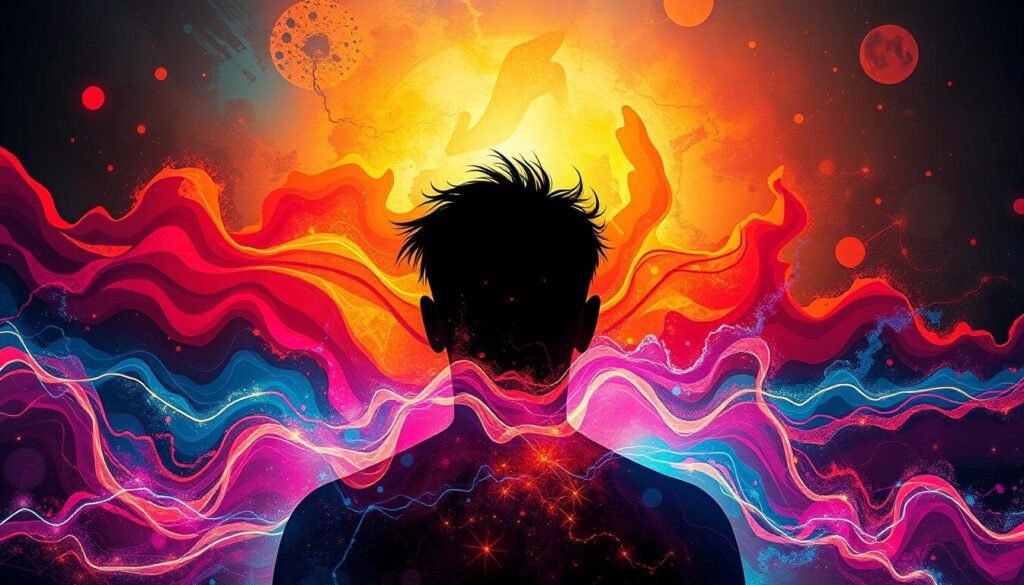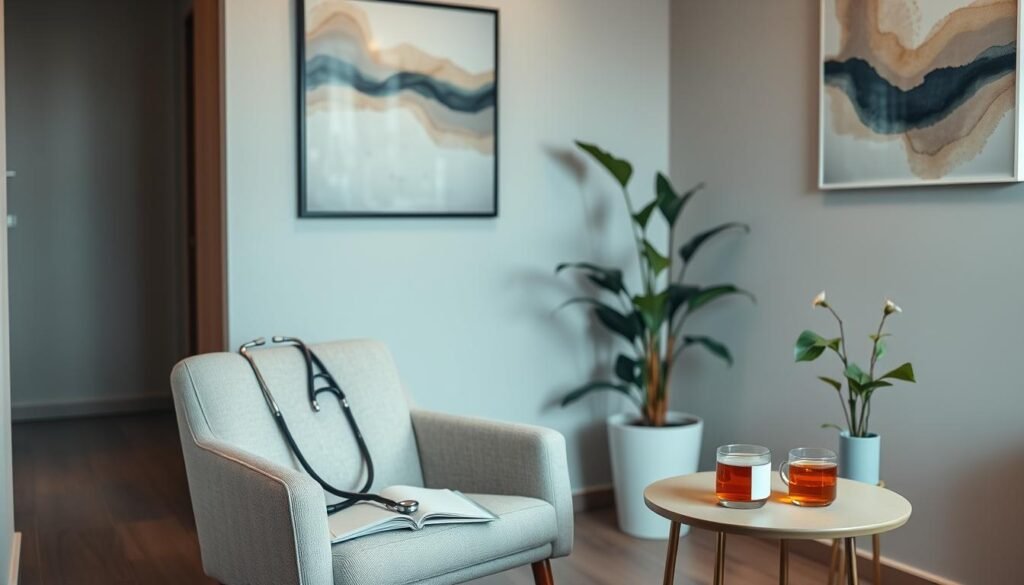Did you know at least 35% of people have felt anxiety attacks once? Anxiety can sometimes make you feel pins and needles. This is called paresthesia. It’s uncomfortable and can worry many people. That’s why it’s important to know why it happens. This article talks about how anxiety can cause these feelings. We will look at how anxiety can impact your mind and body. We’ll also offer tips for anyone who feels this way.
Key Takeaways
- Anxiety triggers various physical symptoms, including pins and needles.
- Hyperventilation is a common cause of anxiety-related sensations.
- Stress often exacerbates the feeling of tingling or numbness.
- Understanding the difference between anxiety and conditions like MS is essential for proper management.
- Effective treatments include therapy, medication, and lifestyle changes.
- Recognizing anxiety symptoms early can improve coping strategies.
Understanding Anxiety and Its Symptoms
Anxiety is a common mental health challenge. It affects people in many different ways. It’s important to understand how anxiety shows up. This helps us recognize its effects on our lives and well-being. Let’s dive into anxiety’s physical impacts and common symptoms.
What Happens in the Body During Anxiety
When we feel anxious, our bodies go through big changes. The autonomic nervous system kicks in for the fight-or-flight response. It pumps out stress hormones like adrenaline and cortisol. Our heart rate and breathing speed up. Blood rushes to our muscles for quick action. For some, this can feel like tingling or pins and needles.
Common Symptoms of Anxiety Disorders
Those with anxiety disorders may experience varied symptoms. They can differ in how strong and how often they appear. Among these are:
- Mood swings
- Anger and irritability
- Panic attacks
- Tingling sensations across the body
- Numbness, especially in hands and feet
- Emotional upset during episodes
These symptoms show the deep connection between our minds and bodies. Stress hormones can make blood vessels narrow. This can cause numbness and tingling. You might feel these sensations in your face, hands, and legs. They can last from a few minutes to a few hours after the anxiety eases.
What Are Anxiety Pins and Needles?
Anxiety pins and needles, or paresthesia, make you feel like a part is asleep. Those with anxiety may often feel a tingling or prickling. It’s key we grasp both the science and personal stories behind these feelings.
Defining Paresthesia: The Science Behind the Sensation
Paresthesia is when your skin feels abnormal, like tingling or numbness. For those with anxiety, this can pop up during panic moments. It can be strong or mild and hit different places. Hyperventilation might cause it, changing blood oxygen and making nerves jumpy.
How Pins and Needles Feel During Anxiety Episodes
During anxiety, people feel all sorts of prickles. It might be a soft buzz or severe discomfort. The face, hands, and feet are common spots. This can mess with concentration and ramp up distress.
To manage these pins and needles, try breathing exercises, moving around, or a quick jog. Things that distract you also work wonders. For deeper solutions, cognitive behavioral therapy is a good road. More tips can be found here.
Mechanisms Behind Anxiety Pins and Needles
Anxiety can cause feelings like pins and needles. This happens because of two main things: the autonomic nervous system and hyperventilation. Together, these factors play a big role in the anxiety-induced symptoms people feel when stressed.
The Role of the Autonomic Nervous System
The autonomic nervous system controls our body’s automatic responses during anxiety. When stressed, this system triggers a fight-or-flight reaction. This can increase your heart rate and make you more alert. It also changes how blood flows through your body. These changes can make nerves more sensitive, leading to feelings of pins and needles during anxiety.
The Impact of Hyperventilation on Sensations
Hyperventilation is common in anxiety and means breathing out too much carbon dioxide. This can upset your body’s blood chemistry. It leads to a condition called respiratory alkalosis. This affects how nerves work and can make tingling feelings stronger. Understanding and controlling hyperventilation can help in managing these uncomfortable sensations better.
Anxiety Tingling Sensations: Causes and Effects
Anxiety leads to various physical feelings, with anxiety tingling sensations being quite common. People feeling these might notice numbness and discomfort. It’s vital to understand these sensations to grasp how anxiety affects us physically.
Stress Hormones and Nerve Sensitivity
When we’re anxious, our bodies release stress hormones like cortisol and adrenaline. These hormones can mess with our blood flow and nerves. As a result, nerves become more sensitive. This heightened sensitivity can cause anxiety tingling sensations in different parts of the body.
High stress levels can make it worse. It might even feel like anxiety circulatory problems, increasing discomfort and tingling.
Specific Body Parts Affected by Tingling
Tingling usually happens in certain areas, such as the:
- Hands
- Feet
- Fingers
- Arms
- Legs
- Toes
This anxiety tingling might happen when moving or even while staying still. For those with anxiety restless legs syndrome, this can be especially uncomfortable. It makes their anxiety even stronger.

| Body Part | Tingling Description | Common Triggers |
|---|---|---|
| Hands | Numbness and prickling | Hyperventilation |
| Feet | Burning or pins and needles | Prolonged sitting |
| Arms | Electric-like sensations | Stress-induced tension |
| Legs | Swelling and discomfort | Inactivity or anxiety spirals |
Understanding these sensations is crucial for dealing with anxiety better. Knowing how anxiety links to physical feelings helps in managing symptoms more effectively.
Connecting Anxiety and Numbness
Anxiety numbness comes from both psychological and physical factors. These factors work together, affecting the body. It’s helpful to know how our brain and body interact. This interaction explains why people with anxiety disorders feel certain symptoms. Because of anxiety, some might feel numbness or tingling in different places.
The Psychological and Physiological Links
Stress hormones like adrenaline can change how nerves work. When we’re under stress, our blood flow might move away from our extremities. This can cause numbness and tingling in hands and feet. Anxiety can also make muscles tense up. This tension can press on nerves and make anxiety numbness worse. When this happens, it can increase pain and discomfort when facing stressful situations.
Comparing Anxiety Numbness to Other Conditions
It’s important to know how anxiety numbness is different from other health issues. Take peripheral neuropathy as an example. It shares some symptoms like nerve pain and less sensitivity. But the reasons for these symptoms are different. Anxiety doesn’t usually harm nerves long-term. But, it can cause temporary symptoms similar to those of nerve disorders. Understanding these differences helps in managing them. Especially if symptoms keep happening. Talking to health experts can help sort out anxiety-related symptoms from other medical issues. This can lead to better understanding and treatment.
Recognizing Anxiety Prickling Feelings
Anxiety prickling feelings feel different than numbness. They often feel like tingling or electric shocks. This awareness can be worrying. Knowing these symptoms helps people understand and manage their anxiety better.
How Prickling Sensations Differ from Numbness
Prickling feelings and numbness are not the same. Numbness makes body parts feel unresponsive. But, anxiety prickling feels like a strong awareness of sensations. These sensations can appear in many body parts due to anxiety. It’s important to know these symptoms to handle them well.
Common Triggers for Prickling Feelings
Many things can trigger anxiety prickling feelings, such as:
- Stress: High stress can make you more sensitive to feelings.
- Poor Posture: Bad sitting or standing can make tingling worse.
- Panic Episodes: Panic attacks often make neuropathy symptoms stronger, leading to prickling.
It’s key to know your triggers. Recognizing them helps find good coping methods. Techniques like deep breathing help. For more tips on managing anxiety, visit this resource.
Managing Anxiety Pins and Needles
Handling the feeling of pins and needles from anxiety is hard. Learning to deal with it well is key to feeling better. Using good strategies can make these bad feelings affect you less in your daily life.
Coping Strategies for Anxiety Symptoms
There are many ways to help lessen the tingling that anxiety brings. Here are a few:
- Mindfulness Practices: Mindfulness or meditation can bring calm and lower anxiety.
- Physical Activity: Activities like light jogging or stretching can help improve blood flow. This might reduce pins and needles.
- Distraction Techniques: Doing things like reading or listening to music can divert your mind from anxiety.
Using these methods when feeling anxious can help you feel more at ease. For more advice on easing these symptoms, visit Healthline.
Breathing Techniques to Reduce Hyperventilation
Breathing methods are great for managing anxiety. They help with over-breathing and make anxiety-related feelings more normal. There are different breathing exercises to try:
- Deep Breathing: Take a slow breath in through your nose for four seconds. Hold it. Then, breathe out for four seconds through your mouth.
- Pursed Lip Breathing: Breathe in deeply. Then breathe out slowly through lips that are almost closed.
- Box Breathing: Inhale for four seconds, hold it, then exhale for four seconds, and hold again. Do it many times.
These breathing methods can help lessen the feeling of pins and needles. If you do them regularly, they can make you better at dealing with anxiety triggers. It’s important to understand how your body reacts to stress.
| Technique | Benefits |
|---|---|
| Deep Breathing | Makes you relaxed and lowers your heart rate. |
| Pursed Lip Breathing | Brings more oxygen to your lungs and makes breathing easier. |
| Box Breathing | Helps you focus and calms your nerves. |
Keeping up with these strategies can really help with anxiety symptoms. If feelings keep on or get worse, talking to a pro might help. They can offer advice to improve how you cope.
When to Seek Medical Help for Anxiety Symptoms
Anxiety can make you feel physical signs, like pins and needles. Having these feelings now and then is normal. But, it’s crucial to know when it’s more serious. You should seek help if anxiety and its symptoms happen a lot or get really bad. This helps doctors check your health and offer the right treatments.
Identifying Serious Health Concerns
When anxiety gets worse, some symptoms shouldn’t be ignored. You should be worried if you notice:
- Prolonged episodes of anxiety-induced pins and needles
- Severe chest pain or difficulty breathing
- Thoughts of self-harm or depression
- Inability to engage in daily activities due to overwhelming anxiety
If you’re facing these issues, reaching out to healthcare professionals is important. They check your anxiety carefully. They make sure to treat any big health worries you might have.
Role of Healthcare Providers in Evaluation
Healthcare providers are key in looking at anxiety symptoms. They use special steps in their checks, which can include:
| Assessment Type | Description |
|---|---|
| Clinical Interview | A talk to learn about what you feel, your health past, and what makes you anxious. |
| Self-Assessment Questionnaires | These are forms to fill out that help figure out how anxious you are and what type it might be. |
| Physical Examination | They check you to make sure other health issues aren’t causing your anxiety signs. |
Asking for help with anxiety leads to getting the right treatment. This might mean therapy, medicine, or both. Knowing when to ask for help can really change how well your mind and body feel.

Proactive Steps to Prevent Anxiety Symptoms
Making early efforts can help stop anxiety symptoms, including that pins and needles feeling. By making healthy choices and looking into therapies like cognitive behavioral therapy, people can feel better. They can also see a drop in anxiety symptoms.
Healthy Lifestyle Changes to Consider
A healthy lifestyle is key to fighting anxiety symptoms. Mental health gets a big boost from exercise, eating right, and getting enough sleep. Below are a few healthy choices to make:
- Regular Exercise: Being active can uplift your spirit and lower stress.
- Balanced Diet: Eating well can balance your mood and energy.
- Quality Sleep: Good sleep is important for handling emotions.
- Mindfulness Practices: Daily mindfulness or meditation reduces stress and increases focus.
- Limiting Alcohol: Drinking less can help stop anxiety symptoms from getting worse.
Therapy Options: Cognitive Behavioral Therapy and Beyond
Cognitive behavioral therapy (CBT) works well for anxiety. It helps people question and change negative thoughts that lead to anxiety. By doing CBT, people often see big improvements. There are other therapies to explore:
- Mindfulness-Based Therapies: These increase awareness and cut down harmful thoughts.
- Talk Therapy: Talking to a therapist can help deal with deep issues.
- Group Therapy: Joining a support group offers new ways to cope.
Following these steps can greatly help in fighting anxiety. It leads to a healthier mind and life.
Conclusion
Understanding anxiety pins and needles helps people recognize symptoms like pain and tingling. This awareness makes managing anxiety easier, allowing people to tell the difference between anxiety sensations and other health issues. By knowing how anxiety and physical symptoms link, you can better handle your feelings.
Common anxiety symptoms include hypersensitivity and muscle tension. These often cause discomfort, especially in the fingers. Knowing these signs leads to improved management, like using breathing exercises or pain relief for discomfort. Activities that distract can also help reduce movement issues and spasms.

Using proactive ways to handle anxiety lessens physical symptoms. This means a more balanced method for overall well-being. Therapy, medication, and support groups are key resources that offer more help against anxiety challenges. Understanding the link between anxiety and physical feelings lets people manage their experiences better, leading to a healthier mindset.
Further Resources and Readings
To better understand anxiety pins and needles, many resources are available. You can find books and online articles helpful. These sources teach about managing anxiety effectively.
There are also professional mental health organizations offering advice. They share ways on how to handle anxiety disorders. Their tips include how to seek help and find coping strategies for anxiety-related issues.
It’s crucial to know about the physical effects of chronic stress and anxiety. Knowing when to see a doctor is important if anxiety symptoms don’t go away and affect your life. For more about anxiety tingling versus other conditions, check out this link: exploring additional resources. This can improve your understanding and help you cope.